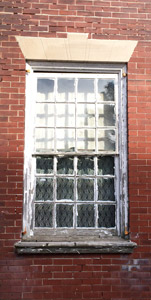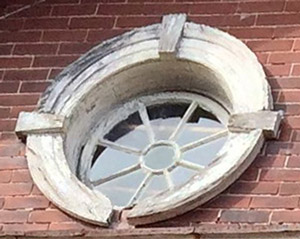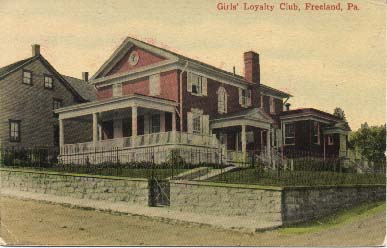
News & announcements
Saving your history
Early accounts
Maps
Nearby towns
People
Churches
Schools
Municipal
Organizations
Businesses
The mines
Transportation
Streets
Buildings
Entertainment
Celebrations
Sports
Ethnic groups
Girls Loyalty Club
What's on this page:
- Schooling for girls
- Girls' Loyalty Club - locations, purpose, teachers, officers
- The building - postcards and photos
- Newspaper coverage of the Girls' Loyalty Club
- Continuation School
- Ss. Peter & Paul's Eastern Greek Catholic Church
- Freeland, then and now
- Gallery of old postcards and modern photographs showing matching
street views, by Charlie Gallagher
- MMI Preparatory School - off-site link
- Sophia Coxe
Foundation / Education Center - off-site link
At upper left: Girls’ Loyalty Club color postcard, a gift from my brother Steve years ago.
Ed Merrick kindly searched out some of the articles documenting the founding and early years of the Girls’ Loyalty Club. Please see the page on Newspaper coverage of the school. Joe Moore sent me the link to Joe Rudawski's 2020 MMI Founders' Day talk; in it Joe Rudawski mentions the girls' school a little past minute 16.
Tom Yaruso and Charlie Reczkowski had relatives who attended the school:
Tom Yaruso wrote: Hi, My aunt Verna Martonis from Highland who arrived in America in 1906 went there to learn sewing, etc.
Charlie Reczkowski told me that his sister also took classes there - he described it as something a bit like a finishing school teaching needlework and other crafts for working class girls. Over a bit more than three decades, apparently hundreds of local girls were members and attended classes, lectures, and club exhibitions.
SCHOOLING FOR GIRLS AT THE TURN OF THE LAST CENTURY
Just as MMI was founded partly on the German model of industrial schools, there was also an industrial school movement for secondary education of girls. Sophia Coxe founded the girls’ school in January 1903 [possible date, based on 11-7-1903 newspaper report] especially for girls working outside the home, as a way to help them to mature into young women able to maintain households and contribute to / participate in society. So when former MMI President Joe Rudawski gave a talk at MMI’s Founders’ Day celebration in November 2020, he said this of Ss. Peter and Paul Church at 921 Walnut street: “The manse to that church is what used to be called first the Industrial School for Girls, and then the Girls’ Loyalty Society. That was MMI’s sister school.”
A large number of children quit school early to go to work in order to help support their families. For boys that often meant the mines. For girls it often meant factories, but also sometimes shops or offices. Continuation School provided a way for working young people to at least continue some part of their basic education [one day a week] so as to build on the basic knowledge they had already received. Industrial schools were another means of educating working children, usually at the secondary level (high school), and often through night classes. There was an emphasis on practical education, which for boys at MMI meant mechanical and engineering subjects, and for girls meant cooking, sewing, and other skills.
GIRLS’ LOYALTY CLUB
Early locations:
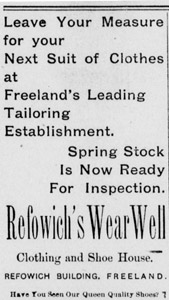
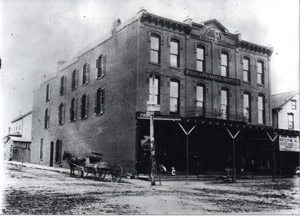 Sophia Coxe decided
that girls who went to work to help support their families needed some
sort of “industrial schooling” to supplement their normal education.
She founded such a school, an evening school for working girls where
they could learn to cook and sew, as well as getting a bit of basic
education and some literary and musical exposure. The school was
originally opened in the Refowich building (the theater was not built
yet, so this would have been what was then the third building down from
the SE corner of Centre and Main, location of Israel Refowich’s
tailoring business – all 3 buildings at that corner would later be torn
down and replaced by the Refowich Theatre building). Then when the
school outgrew that space it moved over to the third floor of the
Birkbeck building (diagonally across Centre and Main from the Refowich
location), opening there on January 1, 1904 after a “complete outfit of
cooking utensils” was installed. One of the upper floors (probably top
floor? - there were business offices on the second floor) of the
Birkbeck building had recently been the temporary home of MMI for
nearly a decade while their new building on Centre below Carbon was
being built. This Birkbeck building photo here came from John Zubach.
Sophia Coxe decided
that girls who went to work to help support their families needed some
sort of “industrial schooling” to supplement their normal education.
She founded such a school, an evening school for working girls where
they could learn to cook and sew, as well as getting a bit of basic
education and some literary and musical exposure. The school was
originally opened in the Refowich building (the theater was not built
yet, so this would have been what was then the third building down from
the SE corner of Centre and Main, location of Israel Refowich’s
tailoring business – all 3 buildings at that corner would later be torn
down and replaced by the Refowich Theatre building). Then when the
school outgrew that space it moved over to the third floor of the
Birkbeck building (diagonally across Centre and Main from the Refowich
location), opening there on January 1, 1904 after a “complete outfit of
cooking utensils” was installed. One of the upper floors (probably top
floor? - there were business offices on the second floor) of the
Birkbeck building had recently been the temporary home of MMI for
nearly a decade while their new building on Centre below Carbon was
being built. This Birkbeck building photo here came from John Zubach.The new location:
 According to
newspaper reporting at the time, the girls’ school remained in the
Birkbeck building until fall of 1910. Ed Merrick found early reporting
on this in the regional newspapers. The Scranton Times-Tribune
reported on December 29, 1908: “Mrs. Coxe Erects School for Girls -
Widow of Wealthy Coal Operator Gives Freeland a Beautiful $30,000
Building.” Then Ed found an article from the Wilkes-Barre Times-Leader
on September 21, 1910, announcing that the new school would open on
October 1, and that it was now called the
Girls’ Loyalty Club. That was the first mention of this name that I’ve
seen in the news coverage of the time. See the page on news coverage of
the school for more.
According to
newspaper reporting at the time, the girls’ school remained in the
Birkbeck building until fall of 1910. Ed Merrick found early reporting
on this in the regional newspapers. The Scranton Times-Tribune
reported on December 29, 1908: “Mrs. Coxe Erects School for Girls -
Widow of Wealthy Coal Operator Gives Freeland a Beautiful $30,000
Building.” Then Ed found an article from the Wilkes-Barre Times-Leader
on September 21, 1910, announcing that the new school would open on
October 1, and that it was now called the
Girls’ Loyalty Club. That was the first mention of this name that I’ve
seen in the news coverage of the time. See the page on news coverage of
the school for more.Purpose:
This is speculation, but it seems to me that the purpose of the Girls’ Loyalty Club shifted over time, from more practical instruction to more focus on artistic and recreational classes. The newspaper coverage suggests this. Such a shift would explain one of the statements justifying the closing of the school in 1934, which said that the institution was "founded for the purpose of providing a recreation center for girls with instructions given in art and needle work, cooking and domestic science." It was in fact founded as a school, but after several decades it may have become more like a recreational center.
In 1903 when the school was founded there were several statements of purpose published. “This school is for the benefit of working girls who are employed in the factories during the day and is the most practical of all our educational institutions.” The school was “… for mill girls and other juvenile workers”. Yet another article said that the school “… fills a very important gap in an educational system, in which the practical needs of the daughters of the wage earner have been altogether overlooked. … A knowledge of cooking and sewing are indispensible accomplishments to the future happiness of girls who will in the natural order become the wives of wage earners.”
In 1905 the school was referred to as the Working Girls’ Industrial School, and in 1908 Sophia Coxe’s intention was cited this way: “She believes that girls destined to be the wives of wage earners, in order to be happy and the mothers of families, should know a little about housekeeping, cooking, needlework and care of children and things of that kind rather than Latin, Greek or Botany.” A 1910 article said that the school affords the working girls an opportunity to “gain a knowledge in cooking and sewing. A course in the common school branches is taught as well as a musical course.”
By the 1920s many of the reported activities of the school seem more artistic or recreational. There were still the annual exhibitions of fancy needlework, later called art needle work. There were fashion shows and corset shows. In 1923 girls from this school joined girls from Freeland High School to put on a basketball game to help St. Luke’s Lutheran church to raise funds for a new church building. Of course it might be that the regular sewing, cooking and other classes just didn’t merit mention in the newspapers. In 1924 they did report on the “excellent progress that is being made here in the study of domestic economy and needle work”, and in 1926 that “activities are devoted to the instruction of working girls”. Occasional visiting speakers and instructors on special topics were noted, such as a presentation on government and civics, and instruction on making surgical dressings, nurses’ aprons, etc., both in 1929. A 1931 newspaper article included this statement: “The Girls’ Loyalty Club is one of the established institutions for girls in Freeland and each year many young women take advantage of the opportunities offered at the club.” This broad statement didn’t repeat the specific purpose from the school’s early years.
In 1934 the Board of Trustees of the Sophia G. Coxe Charitable Trusts announced the closing of the school. A late 1934 announcement of the closing says that the institution was founded as a recreation center for girls with instructions given in art and needle work, cooking and domestic science. The school was not founded as a recreational center, but it may have become one over 30 years.
Part of the January 1935 statement of the trustees reads: “It is believed that the original intent of the club, as formulated by the late Mrs. Eckley B. Coxe, has been fully realized and carried out. During the earlier years of the club, there were no Y. W. C. A.’s in the neighborhood, and church and school societies were few in number. The girls of Freeland have for many years benefited from its instruction and hospitality but since the advent of the modern high school and parish societies for young people, it is believed the Girls’ Loyalty Club has outlived its usefulness – hence its liquidation.”
Directors and instructors (partial list, pulled from newspaper coverage):
Prof. E. F. Hanlon (manager or director in 1903; he was also a principal in the borough schools)
Miss Croll (instructor in “literature and the common branches” mentioned in 1903)
Miss Mary Sweeney (sewing instructor mentioned in 1903; also in 1904, formerly “a Hazle township school teacher and also one of the young ladies selected by Mrs. E. B. Coxe to conduct the evening school opened by that lady in Freeland for the special benefit of working girls”)
Miss Gillespie (instructor in “literature and the common branches” mentioned in 1903)
Miss Mattie Lewis (music instructor added in 1903)
Mrs. E. F. Hanlon (in 1905, an entertainment at the school was “conducted under the auspices of the teachers, Mrs. E. F. Hanlon and Misses Lewis and Sweeney”)
Mrs. E. J. Field (in 1919, “formerly in charge of the Girls’ Loyalty Club in Freeland”)
Miss Catherine/Katherine Beard (in 1922 and 1923, principal of the Girls’ Loyalty Club; in 1926, mentioned as one of the instructors, and in another article as governess; in 1928, resident secretary; in 1934, “the secretary, Miss Beard, has left for Philadelphia to accept another post”)
Miss Nellie Shovelin (in 1923, a member of the Freeland Borough teaching corps, also closely associated with the Girls’ Loyalty Club)
Miss Julia Boyle (in 1923, a member of the Freeland Borough teaching corps, also closely associated with the Girls’ Loyalty Club)
Miss Alice Christy (in 1924, with Anna Cheppa referred to as “directors and active workers of the Girls’ Loyalty Club”)
Miss Anna Cheppa (in 1924, with Alice Christy referred to as “directors and active workers of the Girls’ Loyalty Club”)
Miss Ada Powell (in 1927, formerly “a member of the teaching corps at the Girls’ Loyalty Club”; in 1931, “formerly had charge of the Girls’ Loyalty Club here”)
Officers of the school (at present I only have two years’ officers):
Plain Speaker 9-15-1923: Loyalty Club Officers
New officers of the Girls’ Loyalty Club were elected for the coming year:
President – Irene Berger
Vice President – Mary Contini
Secretary – Anna Palya
Treasurer – Catherine Beard
Standard-Speaker 9-22-1925: Elected Officers
Young women associated with the Girls’ Loyalty Club held a business session and elected a staff of officers for the coming year:
President – Miss Alice Phillips, an attendant in the dental offices of Dr. Lester Trevaskis
Vice President – Miss Anna Evans
Secretary – Miss Susan Misto, the stenographer in the law office of Attorney M. S. DePierro
THE BUILDING
Sophia Coxe died in 1926, and the Girls' Loyalty Club continued for nearly a decade, closing in late 1934. The building was donated in her honor by the Coxe Estate for a new church that was being formed in 1936, Ss. Peter & Paul Eastern Greek Catholic Church. These postcards show the Girls' Loyalty Club before it was modified and expanded for the church. The photos show the building after it was modified to accommodate the church. The 2016-2017 photos show the building in a deteriorated state after its having been empty and untended for some years.
The architecture:
 Here's a note on the
architecture of the building. I received email in 2001-2002 from Bill
Rhoads, a professor in the Art History Department at SUNY New Paltz. In
his first message he wrote: I am an
architectural historian at SUNY New Paltz and am writing a
lecture on the use of colonial revival architecture to assist in
Americanizing immigrants. I have a postcard sent in 1928 showing the
Girls' Loyalty Club in Freeland, a colonial revival-style building
that, I suspect, may have been used to make good citizens of the
children of immigrants. I have seen your web page listing this club,
and I wonder whether you have any suggestions about how I might get
more information about the building and the club.
Here's a note on the
architecture of the building. I received email in 2001-2002 from Bill
Rhoads, a professor in the Art History Department at SUNY New Paltz. In
his first message he wrote: I am an
architectural historian at SUNY New Paltz and am writing a
lecture on the use of colonial revival architecture to assist in
Americanizing immigrants. I have a postcard sent in 1928 showing the
Girls' Loyalty Club in Freeland, a colonial revival-style building
that, I suspect, may have been used to make good citizens of the
children of immigrants. I have seen your web page listing this club,
and I wonder whether you have any suggestions about how I might get
more information about the building and the club.Thank you so much. Your list of the churches in Freeland in 1928 was already useful.
I wrote back, and and later heard from him again:
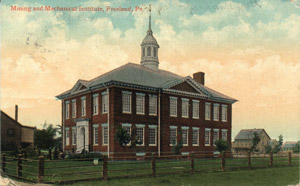
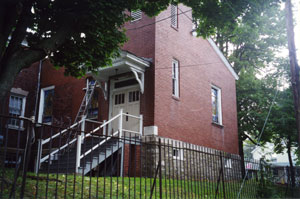 Bill Rhoads: I
want to report that two weeks ago my wife and I visited Freeland
briefly. I was glad to see the Girls' Loyalty Club retains much of its
original appearance. Actually the major change, the addition of the
onion dome for SS. Peter & Paul church, is a nice example of how a
building in the Colonial Revival style (perhaps to encourage
Americanization) could be altered and given a "foreign" appearance,
perhaps indicative of the new arrivals' rejection of at least some
aspects of Americanization efforts. I was also interested to see that
the Mining and Mechanical Institute (c. 1925?) is Georgian or Colonial
Revival in style. [This predated MMI's newest buildings. The
building he referred to is shown here. -
CT]
Bill Rhoads: I
want to report that two weeks ago my wife and I visited Freeland
briefly. I was glad to see the Girls' Loyalty Club retains much of its
original appearance. Actually the major change, the addition of the
onion dome for SS. Peter & Paul church, is a nice example of how a
building in the Colonial Revival style (perhaps to encourage
Americanization) could be altered and given a "foreign" appearance,
perhaps indicative of the new arrivals' rejection of at least some
aspects of Americanization efforts. I was also interested to see that
the Mining and Mechanical Institute (c. 1925?) is Georgian or Colonial
Revival in style. [This predated MMI's newest buildings. The
building he referred to is shown here. -
CT]Postcards:
Here are three postcard views. The first and third are postmarked 1913. The third one is interesting because it shows a little more of the neighborhood on Birvanton Hill; the caption on it says "Girls' Industrial School, Freeland, Pa." A full color postcard is shown just below in the next section.
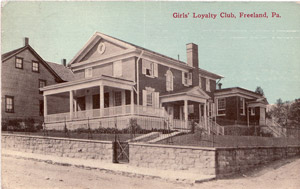

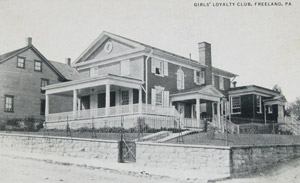

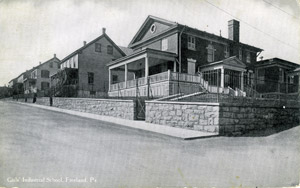
What a difference a century makes:
In his "Then and Now" series of photographs, Charlie Gallagher provided more modern views of sites originally captured in old photographic postcards. He walked around Freeland, looking for the spots where a number of these old postcard views of Freeland streets were photographed from. Once he felt that he was in the right spots, he made new photographs of the same general views, in many cases 100+ years later. Here is his pairing for the Girls’ Loyalty Club and Ss. Peter and Paul Church. The old postcard came from John Zubach. More of Charlie's views around town can be seen on the Freeland Then and Now pages.


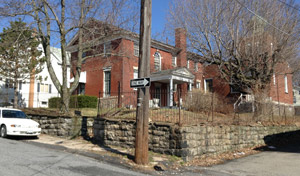
First years of Ss. Peter and Paul Eastern Greek Catholic Church:
Here is what the building looked like soon after it was modified for the newly formed Ss. Peter and Paul Church. Photo courtesy of Basil Macknik, Jr., via Suzy Hoffman and Mike Marine – it was taken when their grandfather Rev. Basil Macknik was pastor of Ss. Peter and Paul Church 1936-1941. Notice the cross added to the porch roof. A few more photos from the time of Rev. Macknik are on a separate page.
I will add that I visited with Mary Kay Wroblewski a few years ago, and during our conversation she reminisced about living in this rectory. Her father, Msgr. Wroblewski, was the most recent and final pastor of Ss. Peter and Paul Church.
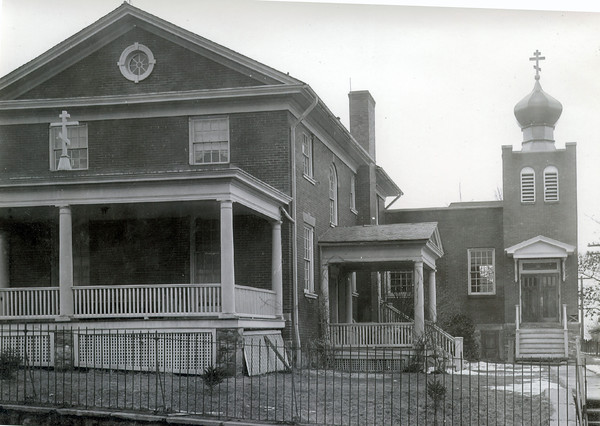
Photos 2010-2011: Modifications
I took the first 3 photos below in 2010-2011. The first one shows the building as seen from the street. If you compare it to the earlier postcard views, you see that the porch had been removed. The center photo shows the church, and the brickwork shows how the church was added to the existing structure at the back of the school building. I am guessing that the structure it was added to had been a hall or auditorium for the school. The third photo is taken from the street, from left front, and you can see the back structure extending. I don't know whether that extended part was original or added for the church. The 4th photo at right was taken in 2017 and shows the view approaching the old school building from the steps. That's how students, teachers and visitors would have approached the building.
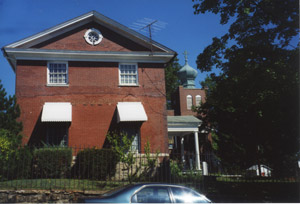

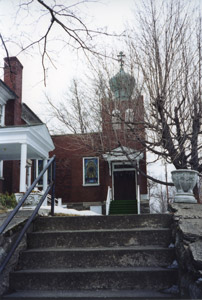

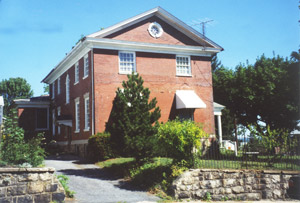

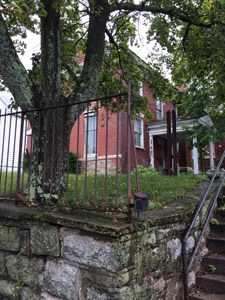
Photos 2016-2017:
Porch and railings:
The cropped view of the bluesky postcard shows the extensive white railings that bounded the porch and the steps up to the porch from the main entrance; there were similar white railings on the steps up to the hall/auditorium in the right area of the photo. By the time the building was modified for the new church, the connection and railings from the main entrance to the porch were gone. In the two later photographs here, the porch is gone as are the railings.
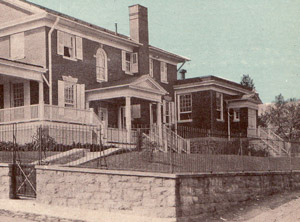



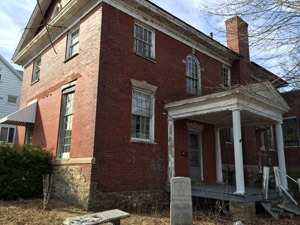

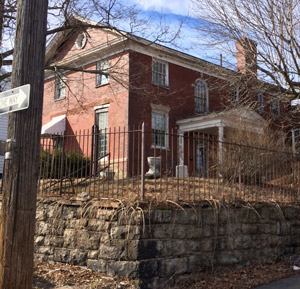
The steps leading up from the sidewalk:
The iron fence and gate, but not the handrail at left of the steps, were original to the school property, or at least they are in the old postcard views made between 1910 and 1913. These photos show how someone would enter the property, coming through the gate, up the steps, and onto the lawn facing the building. This would have been a beautiful entrance to the property in those early decades of the school and then the church.
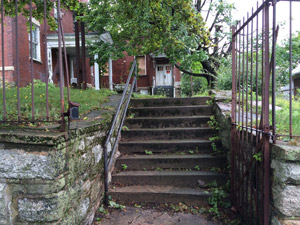

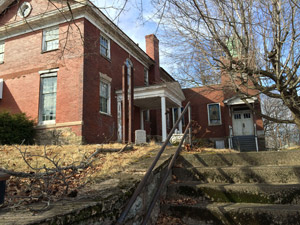

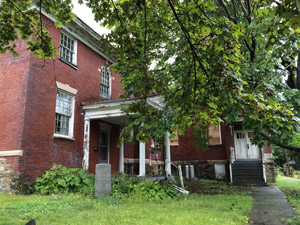
Main entrance:
Look past the deterioration and imagine this rather grand entrance to the school as it would have been. People would come up the steps onto the entrance porch, and there would also have been a connecting walkway with white railings going to the left and connecting to the large porch. The other photo shows the entrance porch without the connecting walkway to the porch.
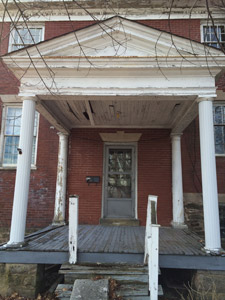

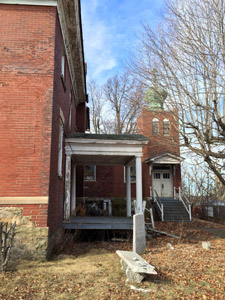
Door to the right of the main entrance:
The 2016 photo shows what look like steps leading up to this additional entrance. The 2017 photo is a bit confusing, because it looks like there is a basement door there. The bluesky postcard 1910-1913 shows steps with railings going up to that door. They are also there in the Rev. Macknick home photo.
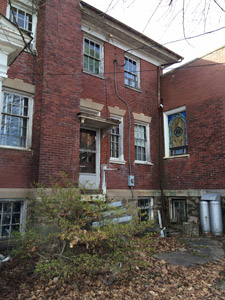

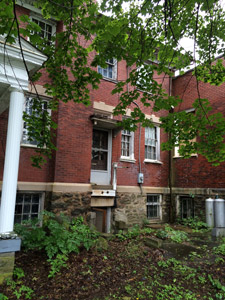


Back door, back view (left side of building as seen from street):
This was the back of the school and rectory, but viewed from the street it was the left side. Even the back side of the building showed attention to architectural details, with stone lintels topping the windows, large ground floor windows and a beautiful round-topped window above the door. The door and small window next to it had roofing - might that have been to shield tradesmen from rain as they were waiting to be admitted with deliveries? Someone inside would be able to open the windown to speak to the person without opening the door. Just a guess. The rightmost photo shows the west end of the church where it extended beyond the school/rectory. Was this part of the original hall/auditorium, or was it an extension for the church?
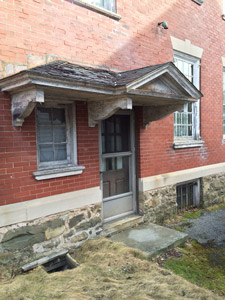

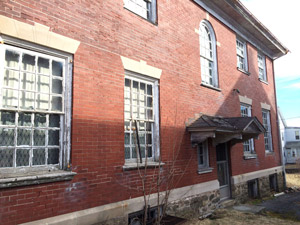

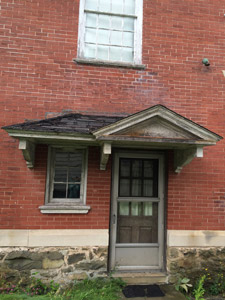

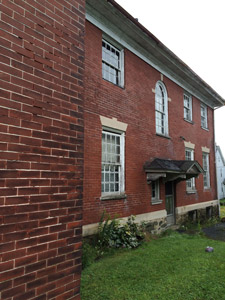
Details:
It's interesting the way the tan stone lintel above the window mimics the Pennsylvania keystone image. The round window on the street side of the building is set within a pediment, giving the building an elegant look. By the time this photo was taken, one of the pieces of the frame had fallen off.
